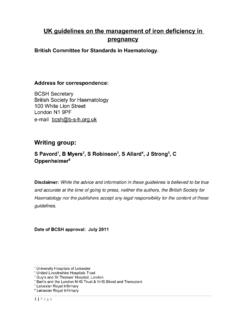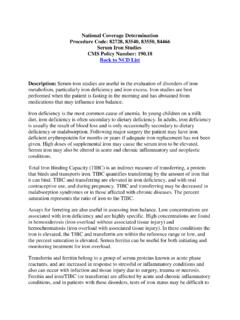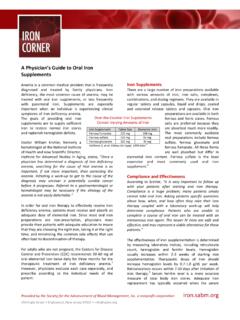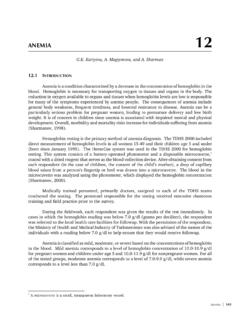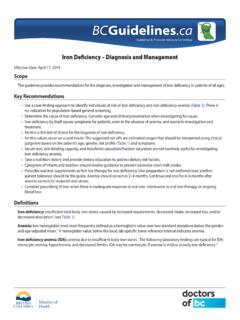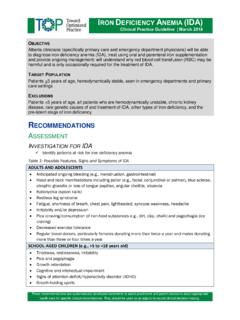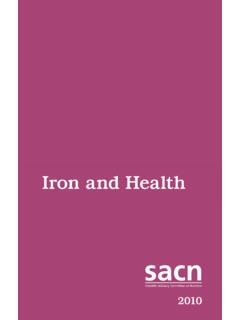Transcription of Iron Deficiency Anemia: Evaluation and Management
1 98 American Family Physician Volume 87, Number 2 January 15, 2013 iron Deficiency anemia : Evaluation and ManagementMATTHEW W. SHORT, LTC, MC, USA, and JASON E. DOMAGALSKI, MAJ, MC, USA Madigan Healthcare System, Tacoma, Washington iron Deficiency anemia is diminished red blood cell production due to low iron stores in the body. It is the most com-mon nutritional disorder worldwide and accounts for approximately one-half of anemia ,2 iron Deficiency anemia can result from inadequate iron intake, decreased iron absorption, increased iron demand, and increased iron Identifying the under-lying etiology and administering the appro-priate therapy are keys to the Evaluation and Management of this of iron Deficiency anemia requires laboratory-confirmed evidence of anemia , as well as evidence of low iron anemia is defined as a hemoglobin level two stan-dard deviations below normal for age and sex (Ta b l e 1).
2 5A complete blood count can be helpful to determine the mean corpuscular volume or red blood cell size. Although iron Deficiency is the most common cause of microcytic anemia , up to 40 percent of patients with iron Deficiency anemia will have normo-cytic As such, iron Deficiency should still be considered in all cases of ane-mia unless the mean corpuscular volume is greater than 95 m3 (95 f L), because this cut-off has a sensitivity of Other causes of microcytosis include chronic inflammatory states, lead poisoning, thalas-semia, and sideroblastic following diagnostic approach is rec-ommended in patients with anemia and is outlined in Figure ,6 -11 A serum ferritin level should be obtained in patients with anemia and a mean corpuscular volume less than 95 m3.
3 Ferritin reflects iron stores and is the most accurate test to diagnose iron Deficiency Although levels below 15 ng per mL ( pmol per L) are consistent with a diagnosis of iron Deficiency anemia , using a cutoff of 30 ng per mL ( pmol per L) improves sensitivity from 25 to 92 percent, and specificity remains high at 98 ,12 Ferritin is also an acute phase reactant and can be elevated in patients with chronic inflammation or infection. In patients with chronic inflammation, iron Deficiency ane-mia is likely when the ferritin level is less than 50 ng per mL ( pmol per L).7 Fer-ritin values greater than or equal to 100 ng per mL ( pmol per L) generally exclude iron Deficiency ,10In patients with no inflammatory states and in whom the ferritin level is indetermi-nate (31 to 99 ng per mL [ to pmol per L]), further tests can be performed to ascertain iron status.
4 Values consistent with iron Deficiency include a low serum iron level, iron Deficiency is the most common nutritional disorder worldwide and accounts for approxi-mately one-half of anemia cases. The diagnosis of iron Deficiency anemia is confirmed by the findings of low iron stores and a hemoglobin level two standard deviations below normal. Women should be screened during pregnancy, and children screened at one year of age. Supple-mental iron may be given initially, followed by further workup if the patient is not responsive to therapy. Men and postmenopausal women should not be screened, but should be evaluated with gastrointestinal endoscopy if diagnosed with iron Deficiency anemia . The underlying cause should be treated, and oral iron therapy can be initiated to replenish iron stores.
5 Paren-teral therapy may be used in patients who cannot tolerate or absorb oral preparations. (Am Fam Physician. 2013;87(2):98-104. Copyright 2013 American Academy of Family Physicians.) Patient information: A handout on iron defi-ciency anemia , written by the authors of this article, is available at Access to the handout is free and unrestricted. Downloaded from the American Family Physician Web site at Copyright 2013 American Academy of Family Physicians. For the private, noncommer-cial use of one individual user of the Web site. All other rights reserved. Contact for copyright questions and/or permission Deficiency Anemialow transferrin saturation, and a high total iron -binding transferrin receptor and erythrocyte protoporphyrin testing.
6 Or bone marrow biopsy can be consid-ered if the diagnosis remains The soluble transferrin receptor level is an indirect measure of erythropoiesis and is increased in patients with iron Deficiency Another benefit of this test is that the soluble transferrin receptor level is unaffected by inflam-matory states and can help identify concomitant iron Deficiency anemia in patients with anemia of chronic Erythrocyte protoporphyrin is a heme precursor and accumulates in the absence of adequate iron If other tests are indeterminate and suspicion for iron Deficiency anemia Table 1. Age-Related Variations in Hemoglobin Level and MCVAgeHemoglobin level (g per dL [g per L])MCV ( m3 [fL])MeanDiagnostic of anemiaMeanDiagnostic of microcytosis3 to 6 months11.
7 5 (115 ) (95)91 (91)74 (74 )6 months to 2 (120 ) (105)78 (78)70 (70)2 to 6 (125)11. 5 (115 )81 (81)75 (75)6 to 12 (135)11. 5 (115 )86 (86)77 (77)12 to 18 years (female) (140 ) (120 )90 (90)78 (78)12 to 18 years (male) (145) (130 )88 (88)78 (78)20 to 59 years (white men) (137)90 (90)80 (80)60 years and older (white men) (132)908020 years and older (white women) (122)908020 to 59 years (black men) (129 )908060 years and older (black men) (127)908020 years and older (black women)NA11. 5 (115 )9080 MCV = mean corpuscular volume; NA = not with permission from Van Vranken M. Evaluation of microcytosis. Am Fam Physician. 2 010 ; 8 2 ( 9 ) :1118 .Diagnosis of iron Deficiency AnemiaFigure 1. Algorithm for diagnosis of iron Deficiency anemia .
8 Information from references 2, and 6 through with anemia , mean corpuscular volume < 95 m3 (95 fL)Ferritin 30 ng per mL ( pmol per L)Ferritin 100 ng per mL ( pmol per L)Increased total iron -binding capacity, low serum iron level, low transferrin saturation Decreased total iron -binding capacity, high serum iron level, high transferrin saturation In patients with any other result, order soluble transferrin receptor testIron Deficiency anemiaFerritin 31 to 99 ng per mL ( to pmol per L)YesNo iron Deficiency anemiaErythrocyte protoporphyrin level increased?Suspicion persists; consider bone marrow biopsyLow bone marrow iron level?NormalIncreasedNoYesNoWorkup for other causes of anemiaDecreasedIron Deficiency Anemia100 American Family Physician Volume 87, Number 2 January 15, 2013persists, the absence of stainable iron in a bone marrow biopsy is considered the diagnostic MEN AND POSTMENOPAUSAL WOMENA symptomatic men and postmenopausal women should not be screened for iron Deficiency anemia .
9 Testing should be performed in patients with signs and symp-toms of anemia , and a complete Evaluation should be performed if iron Deficiency is WOMENThe American Academy of Family Physicians, Pre-ventive Services Task Force, and Centers for Disease Control and Prevention recommend routine screening of asymptomatic pregnant women for iron Deficiency ,11,14 The American College of Obstetricians and Gynecologists recommends screening for anemia and implementing iron therapy if iron Deficiency anemia is The defined values consistent with anemia in pregnancy are hemoglobin levels less than 11 g per dL (110 g per L) in the first or third trimester, or less than g per dL (105 g per L) in the second A maternal hemoglobin level of less than 6 g per dL (60 g per L)
10 Has been associated with poor fetal outcomes, including American Academy of Pediatrics recommends universal hemoglobin screening and Evaluation of risk factors for iron Deficiency anemia in all children at one year of Risk factors include low birth weight, history of prematurity, exposure to lead, exclusive breastfeeding beyond four months of life, and wean-ing to whole milk and complementary foods without iron -fortified The Centers for Disease Control and Prevention recommends screening children from low-income or newly immigrated families at nine to 12 months of age, and consideration of screening for preterm and low-birth-weight infants before six months of age if they are not given iron -fortified The Preventive Services Task Force found insufficient evidence for screening in asymptomatic children six to 12 months of age and does not make recommendations for other A meta-analysis showed that infants in whom cord clamping was delayed for up to two minutes after birth had a reduced risk of low iron stores for up to six Larger randomized studies that include maternal outcomes are needed before delayed cord clamping can be recommended for general iron Deficiency anemia is identified.










